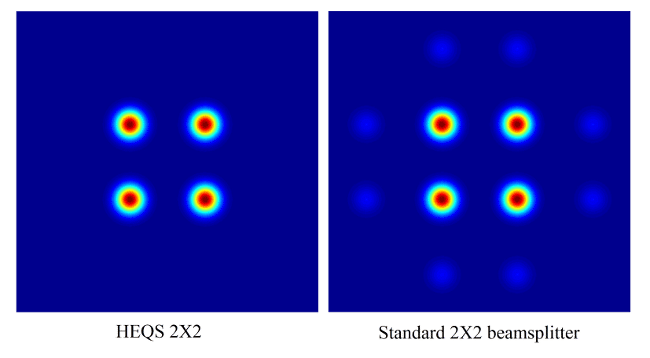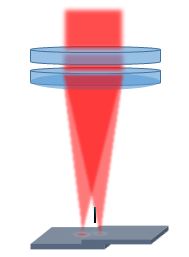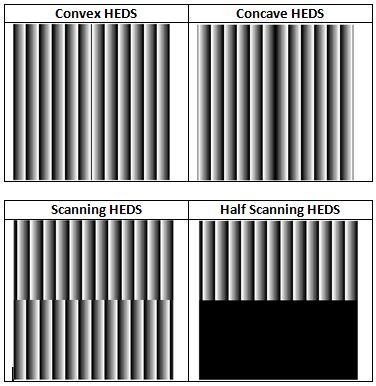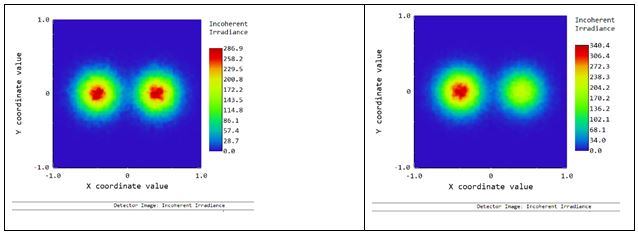HIGH EFFICIENCY 1×2 AND 2×2 BEAM SPLITTERS
Double Spot 1×2 and Quattro Spot 2×2 beam splitting is a highly useful practice in many applications, including welding, lithography, perforation, cutting and other material processing applications. Although our standard Double Spot 1×2 beam splitter (DS) and Quattro Spot 2×2 splitters are highly robust and offer up to 81% and 64% efficiency, respectively, for demanding applications the existence of even 1% input power in undesired higher orders is not tolerable.
For these sensitive applications and for costumers interested in high efficiency, Holo/Or has developed a family of novel diffractive beam splitters: High Efficiency Double Spot (HEDS 1×2) and High efficiency Quattro Spot (HEQS 2×2). For scanning application such as welding and cutting, we offer a specialized sub-type of HEDs- the Scanning HEDs.
Holo/Or’s High Efficiency beam splitters (HEDS) are a special sub-aperture based diffractive optical element (DOE) capable of splitting a beam into Double Spot 1×2 or Quattro Spot 2×2 spots with 97% efficiency and almost no power in undesired orders.
HEDS operate with a sub-aperture approach, and are therefore sensitive to centering and have an effect on the spot shape and size. The spot size in the splitting axis is increased (spot becomes slightly elliptical), and this effect is observed when using single-mode lasers (low M2). For multi-mode lasers the effect is often negligible. We encourage you to contact our Sales for a detailed simulation of the HEDS in your system.
Figure 1: HEDS compared to Standard Double Spot energy distribution
The spot size is defined by the formula:
Where:
DLSM – beam size for M2=1
EFL – Effective focal length
λ – Wavelength
D – Input beam size
M2 – M2 value of input laser beam (beam quality)
For low M2(<~4) the beam in focus will have some ellipticity because of added 0.75.
For higher M2 values the spots will become symmetrical.
HEQS 2×2 splitters increase M2 symmetrically, so no ellipticity will appear, but the spot size will increase for low M2 (single mode) lasers.
Comparison between standard DS/2×2 and HEDS/HEQS
*depends on input beam; for single mode input, centering accuracy of +/- 0.5% diameter gives 2% deviation between orders.
See other Beam Splitter products here and read the application notes.
Scanning HEDS
In recent years, many industrial applications are making a shift towards automation and utilize high power lasers for that purpose. One application that highly benefits from the use of lasers is industrial welding.
Typically, the laser output beam shape is either Gaussian, Super-Gaussian or some other arbitrary shape. These shapes are rarely optimal for industrial laser welding processes. To better tailor the laser output to the process, many welding equipment manufacturers use a Dual-Spot welding process for certain welding scenarios such as:
- Welding of two plates with different thicknesses.
- Welding of different materials.
- Welding at high speeds
HOLO/OR offers a compact and cost effective Dual-Spot welding solution, using our diffractive Beam Splitter technology, with a dedicated High-Efficiency Double Spot element (HEDS). Based on our customers feedback, we have developed dedicated products to better serve the laser welding industry:
- Scanning HEDS – a DOE that consists of two diffractive facets, which split in a direction that is perpendicular to the facet divider.
- Half Scanning HEDS – same as Scanning HEDS, but with a clear region instead of one of the facets (scatters the energy into the original zero order spot).
- HEDS convex – sub-beams converging after HEDS.
- HEDS concave – sub-beams diverging after HEDS.
Standard Scanning HEDS specs:
Typical setup:
Schematic pictures of the diffractive patterns:
General advantages for HEDS family:
- Efficiency > 97 %.
- Wavelength: 193-10600 nm.
- Absolute angular accuracy.
- No dead zones with undefined functionality- 100% of area is optically active.
- Adjustable power per split spot by element shift vs beam.
Advantages of the Scanning HEDS:
- No change in intensity distribution in scanning direction.
Simulation
HOLO/OR endeavors to make integration of its diffractive elements into customers’ optical systems as easy as possible and continuously develops simulation tools, video tutorials and application notes.
References:
- Brodsky, Alexander, et al. “Adjustable‐Function Beam Shaping Methods: Improving throughput, seam height, strength, and the edge smoothness of the joints with process‐specific tailored laser intensity distribution.” PhotonicsViews 16.2 (2019): 37-41.
- Xie, J. “Dual beam laser welding.” Welding journal 81.10 (2002): 223s-230s.
- Hansen, K. S., Morten Kristiansen, and F. O. Olsen. “Beam shaping to control of weldpool size in width and depth.” Physics Procedia 56 (2014): 467-476.
- Cui, Li, et al. “Welding of Dissimilar Steel/Al Joints Using Dual-Beam Lasers with Side-by-Side Configuration.” Metals 8.12 (2018): 1017.
- Mohammadpour, Masoud, et al. “Effect of dual laser beam on dissimilar welding-brazing of aluminum to galvanized steel.” Optics & Laser Technology 98 (2018): 214-228.
- Grajcar, Adam, et al. “Twin-spot laser welding of advanced high-strength multiphase microstructure steel.” Optics & Laser Technology 92 (2017): 52-61.
- Miyashita, Y. “Developments in twin-beam laser welding technology.” Handbook of laser welding technologies. Woodhead Publishing, 2013. 434-465e.
- https://www.twi-global.com/technical-knowledge/published-papers/manufacturing-with-lasers-developments-and-opportunities-july-2004










